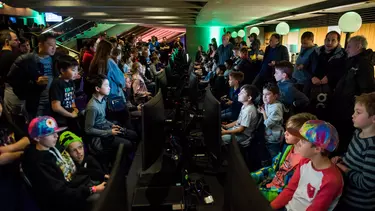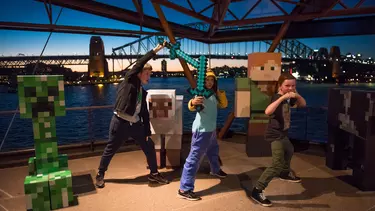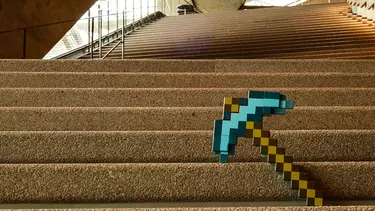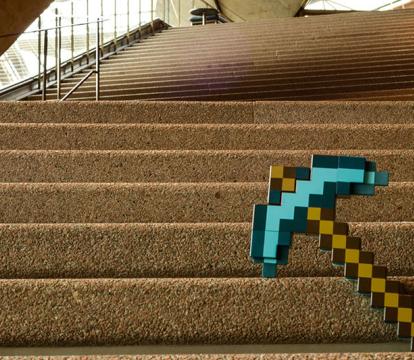Building creativity: Modding the Opera House with Minecraft
The case for education and creative learning in online video games
The first thing ever built in Minecraft, according to online history, was a crude stone fort, alone in a vast and seemingly endless world, with a strange and asymmetrical spire rising out of the middle, pointing up defiantly into a clear blue sky.
Over time, that sky would manifest rain, lightning and snow, and the creator of that fort would be identified as future English Country Tune game developer Stephen "Increpare" Lavelle. Most importantly, though, that rudimentary structure would be built on by hundreds – then thousands, then millions – of users, each creating more complex structures out of simple 3D cubes.
Minecraft, as Lavelle saw it back then, was solely the work of Swedish programmer Markus Persson. It was a seemingly straightforward idea: design an algorithm that could simulate an entire world out of cubes – trees, hills, oceans, caves, clouds – and then let the player both dig that world up and build on it using the same tools. Where other video games privileged violence, or the binary selection of various pieces of scripted narrative, Minecraft stood apart in the simplicity of its premise.
You can build and you can destroy – anything and everything.
Whether it’s to teach children about electronics or encourage them to collaborate in creative pursuits, Minecraft exists as an easy and accessible – and cheap – facilitator of these important lessons.
While the Minecraft of today allows a lot more nuance in how players achieve those results, the guiding principle of “dig and build” remains paramount. It wasn’t the first game to try this idea – as many Persson detractors observed in relation to Minecraft’s earliest releases – but it remains the only game to have sold well in excess of 100 million copies, making it the second-most successful video game of all time, right behind that eternally-evolving gift from the USSR: Tetris.
While Tetris is often used as an easy shorthand for video games as a whole, Minecraft arguably represents something else entirely. There is certainly a “game” in Minecraft, depending on how you play it: you can strip those titular mines, do battle with zombies and dragons, train wolves as pets and take care of a pumpkin plantation. Some players have worked collaboratively on these pursuits, and others have used the game as an analogue of global human conflict, starting online territory wars and resources disputes.
But to the wider world, the thing that keeps players of all ages coming back is that ability to dig and build anything one’s imagination can afford. Players have built entire cities – real and fictional, some borrowed from properties like Game of Thrones, Lord of the Rings and Lost – along with a replica of the 1969 Space Shuttle launch, the Tower of Babel, the USS Enterprise and a level from Sonic the Hedgehog.


The introduction of “redstone” – the mysterious, mineable resource that functions like an electrical conduit and can move and create different cubes – pushed the creative capabilities of Minecraft even further. Redstone has introduced many a player to the basic concepts of circuitry, including logic gates and diodes. In fact, bringing history full-circle, one player has actually managed to organise countless redstone switches to fully recreate a playable version of Tetris within Minecraft; a game within a game. The best-seller built within the second-best.
It’s for these above reasons that Minecraft has become such a global powerhouse, to the extent that it’s now being used as an educational device within many classrooms throughout the world. Whether it’s teaching children about electronics or encouraging them to collaborate in creative pursuits, Minecraft exists as an easy, accessible and cheap facilitator of these important lessons.

In TIME magazine, The Sims and SimCity designer Will Wright described the Minecraft phenomenon quite succinctly: “In scripted games, everybody experiences the same thing — they’re all rescuing the same princess. In Minecraft you use your imagination to create whatever you want. It might be a story, it might be a machine, it might be some interesting place where you can go and play. But whatever it is, it’s a reflection of you and your intention and your creativity.”
Persson no longer oversees Minecraft’s development, having left Mojang – the company he co-founded with Jakob Porsér in 2009 – after Microsoft acquired it for US$2.5 billion in 2014. Minecraft is now spearheaded by Jens Bergensten, who has no intention of letting it rest on its laurels.
He’s seen the incredible creativity players have expressed through the game in the past eight years and is determined to keep evolving the design to facilitate even more creativity. The game isn’t slowing down, and neither is he – perhaps, one day, the things players build in Minecraft will make what we’ve seen already look as primitive as Lavelle’s surrealist fort back in 2009.
The sky, as ever, is the limit.
Alexander Burke is a journalist whose writing has appeared in The Guardian, Eurogamer, Vogue and The Australian.
